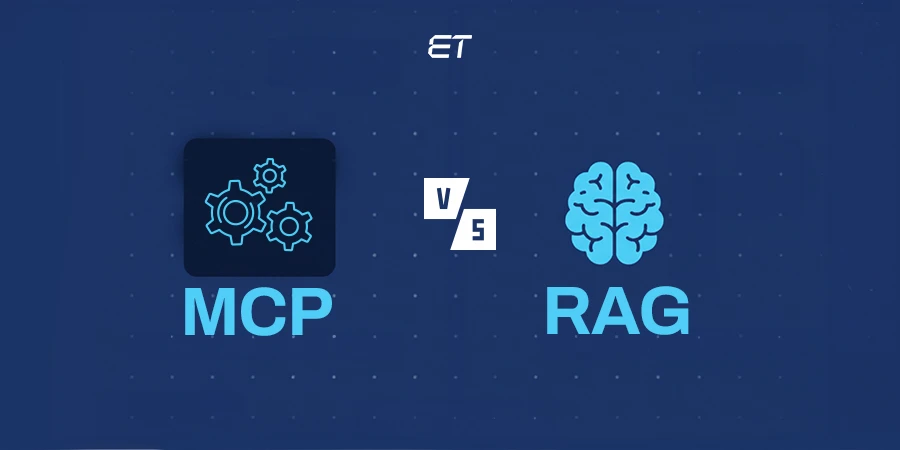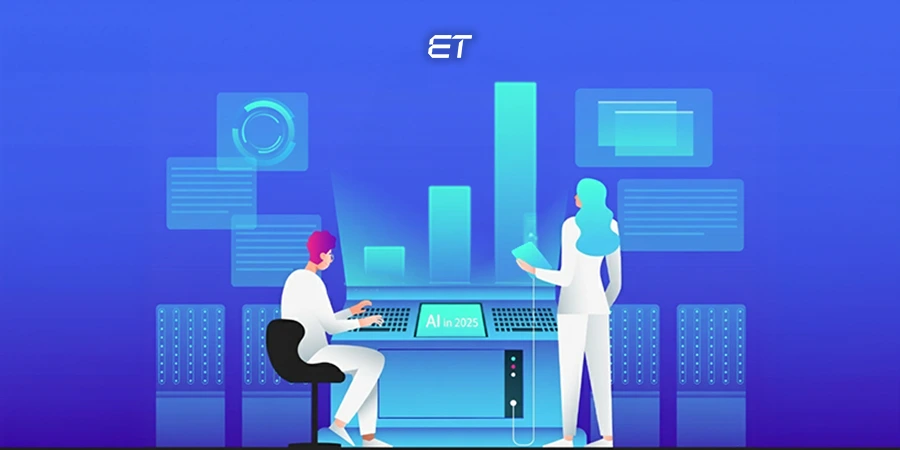
AI Chatbots in Customer Service: Your Strategic Guide to Maximizing ROI
- AI chatbots in customer service enhance user satisfaction by resolving queries quickly and reducing support costs.
- Systematic chatbot implementation requires clear, measurable ROI goals.
- Monitor key metrics like CSAT and support costs per ticket regularly to optimize performance and drive long-term revenue.
- Evaluate potential risks early to ensure quality and avoid service disruptions.
AI chatbots have become the poster boys for quality customer service – answering instantly, cutting costs, and never taking a break.
The global AI chatbot market value will be around USD 31.11 billion in 2029, so the software adoption will keep increasing. AI chatbots in customer service will become indispensable, especially when you’re seeking operational efficiency.
While the buzz about these tools is high, you may wonder – do they actually move the needle? Will these tools boost customer service ROI in the long run?
The answer to both questions is yes. But only if you have a clear chatbot implementation plan and sorted financial targets.
In this post, we’ll explore how AI chatbots enhance customer service and provide practical steps for their integration.
Improve customer service strategies with tailored assistance.
What Are the Benefits of AI Chatbots in Customer Service?
Today’s customers don’t have time. They need quick answers, seamless checkouts, and prompt services. If you can’t offer all that, they’ll switch brands instantly.
Meeting those expectations gets tough when support teams are stretched thin. That’s where AI chatbots come in and strengthen your service delivery:
1. 24/7 Instant Support With Shorter Wait Times
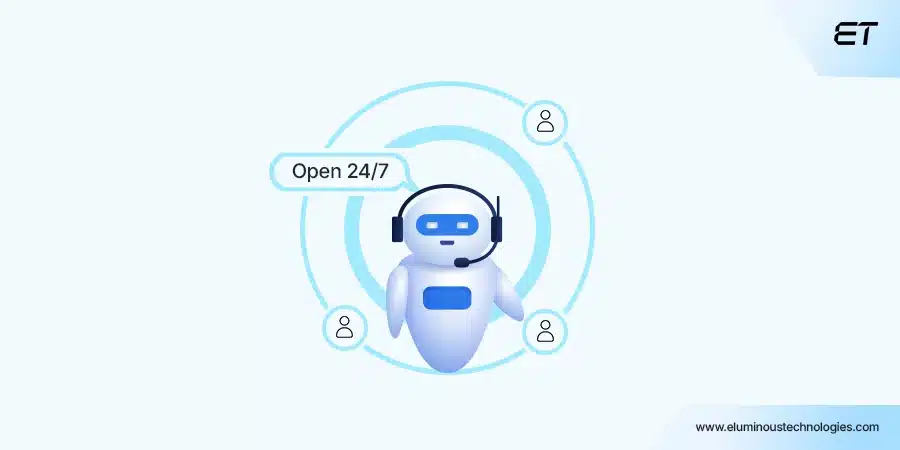
Unlike traditional support teams, AI chatbots in customer service operate 24/7 and never take a break. They provide uninterrupted customer assistance by promptly answering queries.
Whether it’s a late-night password reset or an urgent product query, chatbots deliver consistent service without delays. This means your business can cater to customer queries without time-zone constraints, while gaining other vital benefits:
- No staffing overhead for night shifts or peak hours, which lowers support costs.
- Reduced customer frustration due to long hold times, increasing their satisfaction levels.
- Improved SLA compliance with faster, consistent first-response time.
These chatbots protect revenue, especially during off-hours or product launches, when quick answers can prevent lost sales or leads.
2. Smarter, Personalized Customer Interactions With AI Chatbots
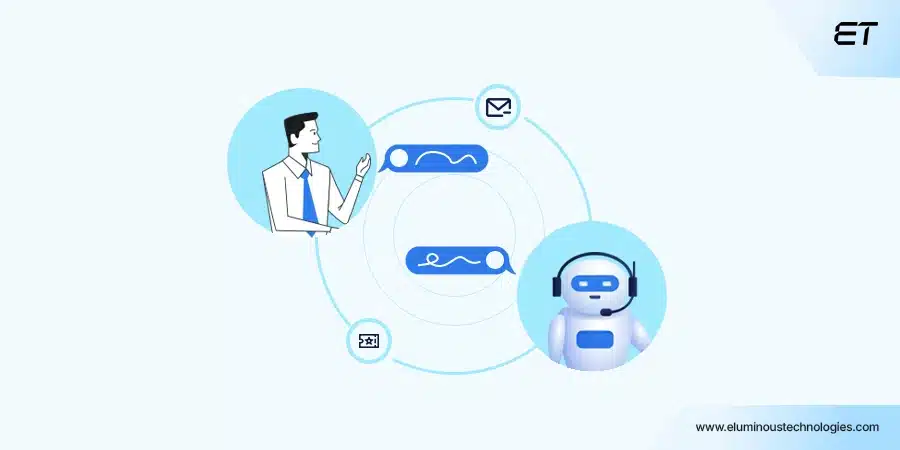
AI chatbots are great at remembering user details and using them during conversations. By tapping into CRM data, past chats, and purchase history, chatbots personalize every interaction.
This makes the interactions more relevant and personal, which positions your brand as customer-focused.
- Chatbots offer product recommendations and solutions based on user data or history.
- Speeds up support by skipping repetitive verification steps.
- Anticipates customer issues early and resolves them before they escalate to human agents.
This kind of personalized automation turns leads into loyal customers. It also boosts upselling and cross-selling with hyper-relevant suggestions.
Explore how chatbots strengthen service, retention, and revenue.
3. Improved Service Quality With Real-Time Customer Feedback
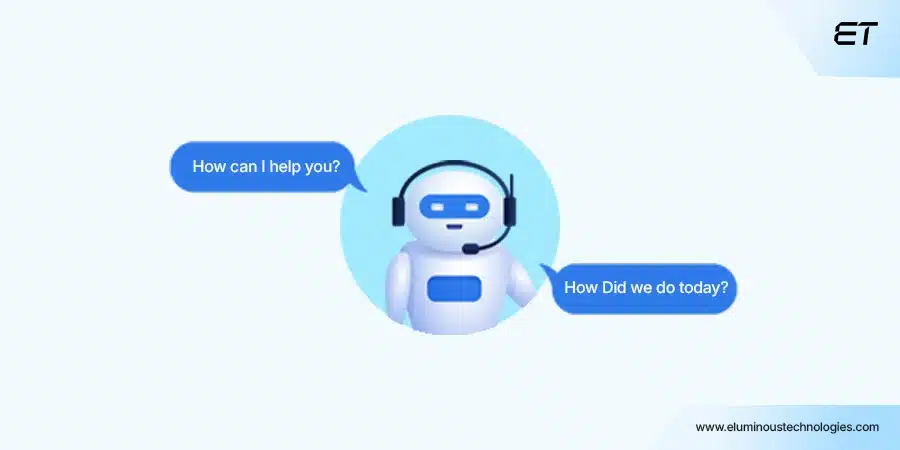
AI chatbots can automatically gather feedback after every customer interaction via post-chat surveys, behavioral data, and interaction logs. This real-time input uncovers service gaps and trends faster than traditional surveys ever could.
You can track, analyze, and improve service quality without waiting for costly audits or delayed reports. Here’s what you get:
- Capture thumbs-up/down ratings instantly after chat.
- Identify recurring complaints or friction points for process improvement.
- Enables quick iterations to chatbot scripts and workflows.
Over time, real-time feedback lowers support costs and drives loyalty, keeping your service lean, smart, and customer-focused.
4. Expand Global Reach With Multilingual AI Chat Support

AI chatbots in customer service can interact in multiple languages, delivering consistent support globally across diverse customer bases. Using NLP and real-time AI translation, chatbots respond in 100+ languages with contextual accuracy.
Here’s how multilingual support helps scale your global customer base:
- Offer consistent brand messaging across geographies.
- Increases customer satisfaction in non-English-speaking regions.
- Enter new markets faster with minimal added support costs.
Therefore, multilingual support becomes a growth enabler for international brand growth and better brand image.
6 Practical Steps to Maximize ROI From AI Chatbots in Customer Service
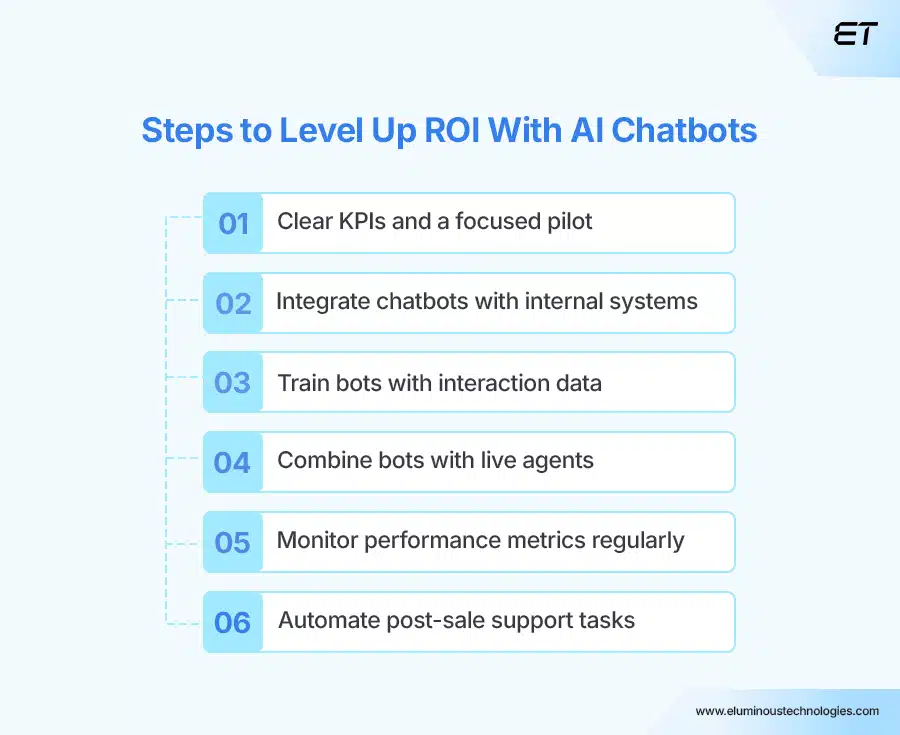
AI chatbots only deliver ROI when you implement a robust strategy. Like any tech rollout, success depends on having a clear, structured plan. Like every software implementation or integration, it starts with a systematic plan, which we’ll cover in this section.
Here’s a step-by-step roadmap to help you deploy AI chatbots in customer service effectively and get measurable returns.
Step #1: Start with a Targeted Pilot and Clear KPIs
Firstly, begin with a small, controlled pilot or chatbot deployment rather than a full-scale rollout. This minimizes risks and allows your team to validate performance, measure outcomes, and make decisions accordingly.
Start by selecting a specific use case, such as automating order status queries or handling password resets. Ensure it has high volume and low complexity. This ensures faster wins and clearer visibility into cost savings and efficiency gains.
Then, define the KPIs you wish to track, aligned to your business goals:
- Response Time Reduction – Measures how much faster customers receive replies compared to previous response times.
- First Contact Resolution Improvement (FCR) – Tracks an increase in issues resolved during the first interaction, without follow-up or escalation.
- Customer Satisfaction Scores (CSAT) – Reflects customer happiness based on post-interaction surveys or ratings.
- Support Cost Per Ticket – Calculates the average cost your business incurs to resolve one customer support request.
Use these KPIs to evaluate financial performance and operational impact. If the pilot shows strong results, scale it gradually to more use cases and teams.
Step #2: Integrate Chatbots with CRM and Support Platforms for Contextual Conversations
To unlock real ROI, chatbots must integrate with your core business systems, particularly CRMs and support platforms. Without integration, chatbots run blind, unable to personalize responses or resolve issues effectively.
So, utilize APIs or pre-built connectors to integrate chatbots with CRM and support platforms. When connected with CRMs like Salesforce and support tools like Zendesk, chatbots can access customer history, open tickets, and user preferences.
Key benefits of integration include:
- A seamless support experience that reduces agent workload and improves resolution speed.
- Auto-fill forms or ticket details using stored customer data.
- Escalate complex issues to the right agent with full context.
- Deliver real-time insights to sales, marketing, and service teams.
For successful integration, verify that internal systems comply with relevant data privacy regulations. Select chatbot vendors offering out-of-the-box connectors or flexible APIs to minimize implementation time.
Looking for a new CRM for customer support?
Step #3: Continuously Train Chatbots With Real Data for Smarter Interactions
AI chatbots in customer service are not “set-and-forget” tools. That’s why training bots with real-time interaction data is so essential for maximizing their utility.
It helps bots handle queries more intelligently over time, improving resolution rates and reducing reliance on human agents. Identifying and fixing knowledge gaps in bots is also effective this way.
Here’s how to keep your bots sharp, useful, and aligned with real-world needs:
- Set up regular reviews of chatbot transcripts and feedback.
- Collaborate with customer service teams to update bot logic and FAQs.
- Use analytics to identify repeated failure points and optimize responses.
- Establish a feedback loop to refine language models and tone.
Investing in continuous learning reduces long-term support costs and improves customer satisfaction. This aspect drives better service outcomes without adding headcount.
Step #4: Blend Bots with Live Agents for Complex Queries
While AI chatbots handle routine tasks efficiently, combining them with human agents is essential for managing high-value queries.
This hybrid model ensures customers receive both speed and empathy, which significantly impacts user satisfaction. Chatbots can act as the first line of support, resolving common issues and collecting context before escalating to agents.
Use these tactics to make bot-agent handoffs seamless and efficient:
- Set clear rules to escalate complex issues by topic, tone, or priority level.
- Make sure bots transfer chats smoothly to agents without restarting the conversation.
- Measure how quickly and effectively both bots and agents resolve customer issues.
- Analyze chatbot data to improve escalations and reduce manual agent involvement.
The approach controls costs while preserving the human touch, enhancing long-term customer loyalty. With chatbots handling routine tasks, human agents can focus only on cases that truly require their expertise.
Step #5: Track Key Metrics and Optimize for Continuous ROI
To keep driving ROI, you need to track performance and fine-tune your chatbot regularly. Regular monitoring ensures the chatbot continues to meet business goals, improve customer experience, and reduce support expenses.
Track key metrics like response time reduction, customer satisfaction scores, and support cost per ticket regularly. These insights help identify what’s working, what needs fixing, and where additional ROI can be unlocked.
Use these steps to evaluate and improve chatbot performance:
- Benchmark chatbot performance against industry standards or internal KPIs.
- Collaborate with IT and customer experience teams to prioritize updates based on high-impact metrics.
- Review dashboards weekly or monthly with operations leaders.
- Set thresholds and alerts for underperformance.
Also, allocate a budget for periodic optimization and bot retraining.
Step #6: Automate Post-Sale Support to Reduce Costs and Boost Satisfaction
AI chatbots in customer service are great for automating post-sale tasks like order tracking, return requests, and refund processing. Automating such high-volume tasks saves time, effort and eventually increases your ROI.
By letting chatbots handle these workflows, you can minimize manual labor, lower support ticket volume, and speed up resolution times.
Here’s how to go about it:
- Identify the most frequent post-sale queries by volume and cost.
- Work with tech teams to map automation flows into chatbot scripts.
- Ensure chatbot integration with order management and payment systems.
- Set performance benchmarks and track improvements over time.
- Monitor reduction in tickets and customer wait times to quantify ROI
These steps substantially save time spent on post-sale tasks, reduce manual effort, and enhance customer satisfaction.
As a result, you achieve higher retention, fewer refunds, and better revenue per customer.
AI Chatbots in Customer Service: Key Risks and How to Mitigate Them
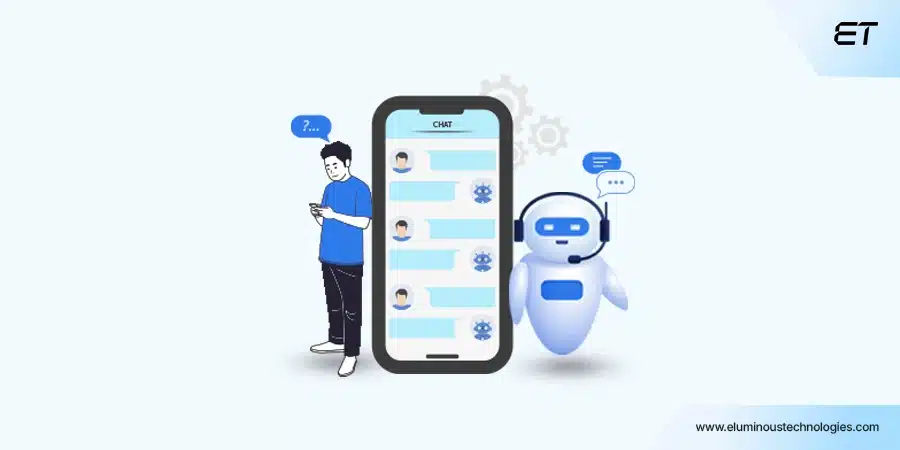
While AI chatbots offer strong ROI potential, poor implementation can hamper customer satisfaction and service standards. Let’s examine potential implementation risks and their solutions.
Inaccurate Responses: Continuously train bots using real interaction data and monitor quality regularly.
Integration Challenges with Legacy Systems: Choose chatbot platforms with flexible APIs and proven integration support.
Data privacy and Compliance Issues: Ensure bots comply with GDPR, CCPA, and internal data governance standards.
Poor User Adoption or Internal Resistance: Involve customer service teams early and provide onboarding for smooth adoption.
Proactively addressing these risks protects customer experience and ensures your AI chatbots in customer service deliver sustained returns.
Prevent bottlenecks and empower strategies with pro developers.
Wrapping Up
AI chatbots in customer service are revenue-driving tools when deployed with intention. To drive ROI, align your chatbot strategy with clear goals like cutting costs, improving CX, and scaling service.
With the right KPIs, integrations, and feedback loops, every chatbot interaction becomes a measurable win.
Ultimately, smart chatbot investments reduce operational costs and increase customer lifetime value, helping you scale support successfully.
Transform your support with AI. Speak to our specialists today.
Frequently Asked Questions
1. How are AI chatbots used in customer service?
AI chatbots in customer service handle routine queries, offer instant support, automate workflows, and escalate complex issues.
2. How to set up an AI chatbot for customer service?
To set up AI chatbots in customer service, define KPIs, integrate with CRM, set escalation rules, and train with interaction data.
3. What are the different types of chatbots for customer service?
The common types of AI chatbots in customer service include:
- Rule-based Chatbots – Follows scripted flows for predictable questions.
- AI-powered Chatbots – Uses NLP to understand and respond naturally.
- Hybrid Chatbots – Combines automation with live agent escalation.
- Voice-Enabled Chatbots – Interacts using speech for hands-free support.
Implement the chatbot according to business goals and KPIs.

